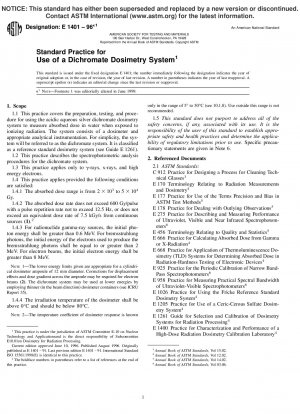ASTM E1401-96e1
- Standard No.
- ASTM E1401-96e1
- Release Date
- 1970
- Published By
- /
- Latest
- ASTM E1401-96e1
- Scope
- Full Description 1.1 This practice covers the preparation, testing, and procedure for using the acidic aqueous silver dichromate dosimetry system to measure absorbed dose in water when exposed to ionizing radiation. The system consists of a dosimeter and appropriate analytical instrumentation. For simplicity, the system will be referred to as the dichromate system. It is classified as a reference standard dosimetry system (see Guide E 1261). 1.2 The practice describes the spectrophotometric analysis procedures for the dichromate system. 1.3 This practice applies only to [gamma] rays, x rays, and high-energy electrons. 1.4 This practice applies provided the following conditions are satisfied: 1.4.1 The absorbed dose range is from 2 X 10 to 5 X 10 Gy. 1.4.2 The absorbed dose rate does not exceed 600 Gy/ pulse with a pulse repetition rate not to exceed 12.5 Hz, or does not exceed an equivalent dose rate of 7.5 kGy/s from continuous sources (1). 1.4.3 For radionuclide gamma-ray sources, the initial photon energy shall be greater than 0.6 MeV. For bremsstrahlung photons, the initial energy of the electrons used to produce the bremsstrahlung photons shall be equal to or greater than 2 MeV. For electron beams, the initial electron energy shall be greater than 8 MeV. Note 1-The lower energy limits given are appropriate for a cylindrical dosimeter ampoule of 12 mm diameter. Corrections for dose gradients across an ampoule of that diameter or less are not required. The dichromate system may be used at lower energies by employing thinner (in the beam direction) dosimeter containers (see ICRU Report 35). 1.4.4 The irradiation temperature of the dosimeter shall be above 0°C and should be below 80°C. Note 2-The temperature coefficient of dosimeter response is known only in the range of 20° to 50°C (see 10.1.8). Use outside this range is not recommended. 1.5 This standard does not purport to address all of the safety concerns, if any, associated with its use. It is the responsibility of the user of this standard to establish appropriate safety and health practices and determine the applicability of regulatory limitations prior to use. Specific hazard statements are given in Note 6.
ASTM E1401-96e1 Referenced Document
- ASTM C912 Standard Practice for Designing a Process for Cleaning Technical Glasses*, 1993-04-22 Update
- ASTM E1026 Standard Practice for Using the Fricke Reference Standard Dosimetry System*, 1995-04-22 Update
- ASTM E1205
- ASTM E1261
- ASTM E1400
- ASTM E170 Standard Terminology Relating to Radiation Measurements and Dosimetry*, 1999-04-22 Update
- ASTM E1707
- ASTM E177 Standard Practice for Use of the Terms Precision and Bias in ASTM Test Methods*, 1990-04-22 Update
- ASTM E178 Standard Practice for Dealing With Outlying Observations*, 1994-04-22 Update
- ASTM E275 Standard Practice for Describing and Measuring Performance of Ultraviolet, Visible, and Near-Infrared Spectrophotometers*, 1993-04-22 Update
- ASTM E456 Standard Terminology for Relating to Quality and Statistics*, 1996-04-22 Update
- ASTM E666 Standard Practice for Calculating Absorbed Dose From Gamma or X Radiation*, 1997-04-22 Update
- ASTM E668 Standard Practice for Application of Thermoluminescence-Dosimetry (TLD) Systems for Determining Absorbed Dose in Radiation-Hardness Testing of Electronic Devices*, 2020-07-01 Update
- ASTM E925 Standard Practice for Monitoring the Calibration of Ultraviolet-Visible Spectrophotometers whose Spectral Slit Width does not Exceed 2 nm*, 2002-03-10 Update
- ASTM E958 Standard Practice for Measuring Practical Spectral Bandwidth of Ultraviolet-Visible Spectrophotometers*, 1993-04-22 Update
ASTM E1401-96e1 history
- 1970 ASTM E1401-96e1
